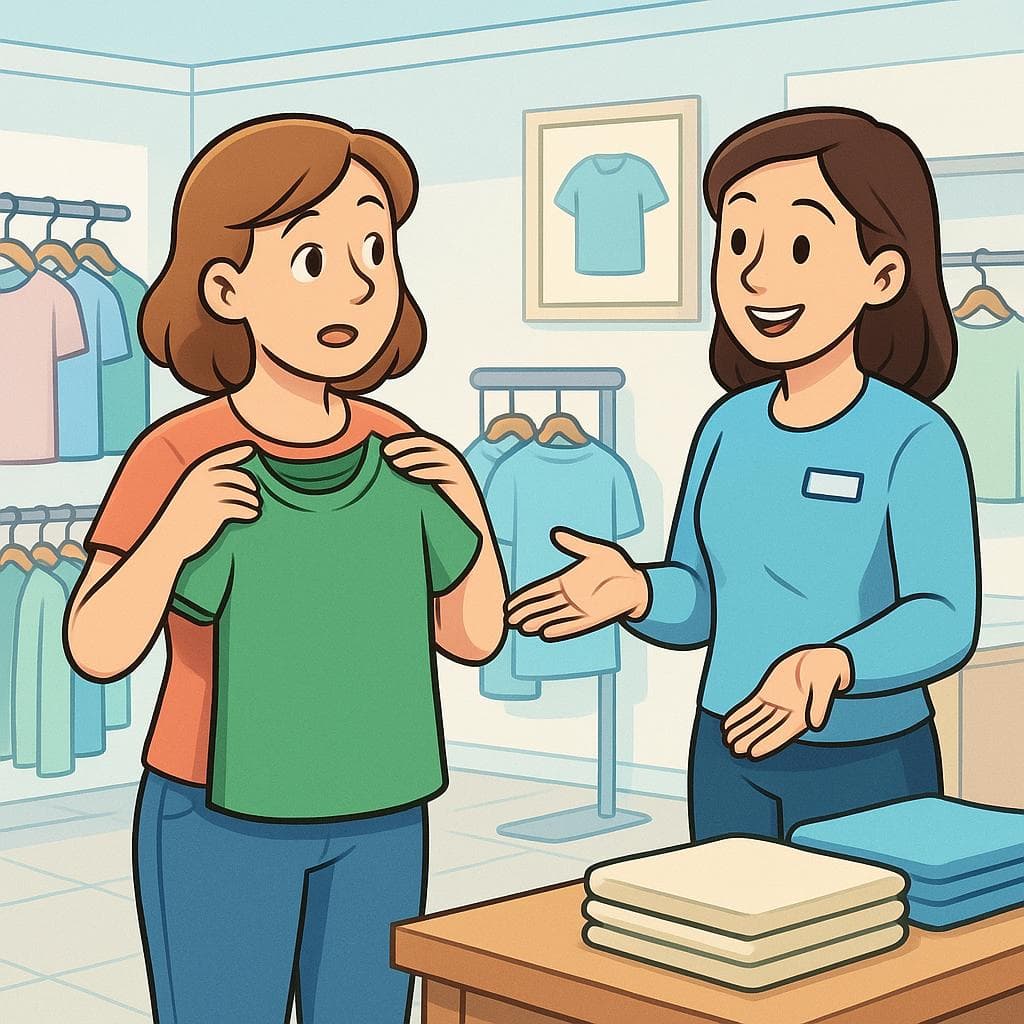Can I try this on?
in Spanish¿Puedo probármelo?
/PWEH-doh proh-BAR-meh-loh/
This is the most standard, versatile way to ask to try on a piece of clothing. It works in almost any store, from a street market to a mall.

When you find something you like, use '¿Puedo probármelo?' to ask if you can take it to the fitting room.
💬Other Ways to Say It
¿Me lo puedo probar?
/meh loh PWEH-doh proh-BAR/
This means exactly the same thing as the primary translation, but the word order is different. It is extremely common in spoken Spanish.
¿Podría probármelo?
/poh-DREE-ah proh-BAR-meh-loh/
Uses the conditional tense ('Could I...') to sound softer and more polite.
¿Dónde están los probadores?
/DOHN-deh ehs-TAHN lohs proh-bah-DOH-rehs/
Literally 'Where are the fitting rooms?' asking this implies you want to try something on.
Quisiera probarme esto
/kee-see-EH-rah proh-BAR-meh EHS-toh/
'I would like to try this on.' A polite statement rather than a question.
¿Me puedo probar estos?
/meh PWEH-doh proh-BAR EHS-tohs/
The plural version. Use this for shoes, pants, earrings, or glasses.
🔑Key Words
Key Words to learn:
📊Quick Comparison
There are three main ways to structure this request depending on where you put the pronouns.
| Phrase | Formality | Best For | Avoid When |
|---|---|---|---|
| ¿Puedo probármelo? | Neutral | Standard shopping situations | You struggle with long words (pronunciation is tricky) |
| ¿Me lo puedo probar? | Neutral/Casual | Everyday conversation | Never - this is always acceptable |
| ¿Podría probármelo? | Formal | Luxury stores or being extra polite | Talking to a street vendor (might sound too stiff) |
📈Difficulty Level
The challenge is the cluster of pronouns at the end: '...bármelo'. It requires stressing the 'BAR' and sliding through the rest quickly.
Requires understanding reflexive verbs (probarse) and object pronouns (lo/la), plus knowing where to place them.
Fairly straightforward, though politeness levels vary slightly by country.
Key Challenges:
- Pronouncing the combined word 'probármelo' smoothly
- Remembering to use 'se' (reflexive) not just 'probar'
💡Examples in Action
Disculpe, me gusta esta camisa. ¿Puedo probármela?
Excuse me, I like this shirt. Can I try it on?
¿Tienen probadores? Quiero ver cómo me queda.
Do you have fitting rooms? I want to see how it fits me.
Estos zapatos son talla 40. ¿Me los puedo probar?
These shoes are size 40. Can I try them on?
Perdona, ¿podría probarme este vestido en otra talla?
Excuse me, could I try this dress on in another size?
🌍Cultural Context
The 'Probador' Limit
In many Spanish and Latin American clothing stores (especially chains like Zara or Mango), there is a strict limit on how many items you can take into the fitting room at once—usually six. You might hear the attendant say 'solo seis prendas' (only six items) and give you a numbered plastic tag.
Service Style Differences
In Mexico and Colombia, service can be very attentive. Assistants might hover nearby and ask frequently '¿Cómo le quedó?' (How did it fit?) or '¿Le paso otra talla?' (Should I hand you another size?). In Spain, the experience is often more independent, and you might need to actively flag someone down.
Vocabulary: Vestidor vs. Probador
While 'probador' is the universal word for fitting room/changing room, in some parts of South America (like Argentina and Uruguay), you might also hear 'vestidor'. However, 'probador' is understood everywhere in a retail context.
❌ Common Pitfalls
Using 'Probar' instead of 'Probarse'
Mistake: "Saying '¿Puedo probarlo?' (without the reflexive 'se/me')"
Correction: ¿Puedo probármelo?
Using 'Intentar' for 'Try'
Mistake: "Saying 'Quiero intentar la camisa'"
Correction: Quiero probarme la camisa
Mixing up 'lo' and 'la'
Mistake: "Saying '¿Puedo probármelo?' for a shirt (camisa)"
Correction: ¿Puedo probármela?
💡Pro Tips
The 'Me queda' Rule
After trying something on, you don't say 'I like it' or 'It is good.' You usually talk about the fit using the verb 'quedar'. 'Me queda bien' (It fits well) or 'Me queda pequeño' (It fits small/it's too small).
Gesture Context
If you forget the complex grammar of 'probármelo,' you can simply hold up the item, point to the fitting rooms, and ask '¿Se puede?' (Is it allowed?). Context does the heavy lifting for you!
Asking for the Fitting Room
Often, you don't need to ask permission to try something on, you just need to find where to do it. Asking '¿El probador?' (The fitting room?) while looking around is perfectly acceptable shorthand.
🗺️Regional Variations
Spain
In Spain, interactions are often more direct. You might just ask where the fitting rooms are ('¿Los probadores?') rather than asking for permission.
Mexico
In Mexico, politeness is paramount. You might hear 'medirse' (to measure oneself) used as a synonym for trying on clothes: '¿Se lo quiere medir?'.
Argentina
You will hear 'vestidores' more often than 'probadores' here. The tone is generally informal (voseo), so assistants will treat you like a friend.
💬What Comes Next?
The assistant points you to the fitting room
Sí, claro. Los probadores están al fondo.
Yes, of course. The fitting rooms are at the back.
¡Gracias!
Thanks!
You come out and it doesn't fit
¿Qué tal le quedó?
How did it fit?
Me queda un poco apretado. ¿Tiene una talla más grande?
It's a bit tight. Do you have a larger size?
It fits perfectly
¿Se lo lleva?
Will you take it?
Sí, me lo llevo.
Yes, I'll take it.
🧠Memory Tricks
Think of 'PRO-BAR'. You go to a BAR to TASTE drinks. In Spanish, you also 'taste' (test) your clothes on your body to see if you like them.
🔄How It Differs from English
In English, we use the phrasal verb 'try on'. In Spanish, this concept is packaged into a single reflexive verb 'probarse'. Also, Spanish requires you to change the pronoun (lo/la/los/las) depending on the gender of the item, whereas English just uses 'it' or 'them'.
False Friends & Common Confusions:
Why it's different: If you translate this as '¿Puedo probar esto?', it usually implies tasting food or testing a gadget, not wearing clothes.
Use instead: Always add the reflexive pronoun: '¿Puedo probarME esto?'
🎯Your Learning Path
➡️ Learn Next:
How to ask for a different size
Once you try it on, it might not fit, so this is the immediate next step.
How to say it fits well or badly
You need to be able to describe the result of trying it on.
How to ask how much something costs
If it fits, your next question will be about the price.
✏️Test Your Knowledge
💡 Quick Quiz: Can I try this on?
Question 1 of 3
You are holding a pair of jeans (pantalones - masculine plural). How do you ask to try them on?
Frequently Asked Questions
Why is there a 'se' or 'me' added to 'probar'?
That makes the verb reflexive. 'Probar' alone means to test or taste. 'Probarse' (probar + se) means to test something *on yourself*, which is how Spanish describes trying on clothes.
Can I just say 'fitting room' in Spanish?
Yes! If you hold up the clothes and ask '¿El probador?' (The fitting room?), it is a perfectly natural way to ask where to go, implying you want to try them on.
What if I want to try on shoes?
The verb is the same ('probarse'), but you usually use the plural pronoun because shoes come in pairs. You would say '¿Me los puedo probar?' (Can I try them on?).
Do I always have to ask permission?
Not always. In large department stores with open fitting room areas, you might just walk in. But in smaller boutiques or stores where fitting rooms are locked, asking is necessary.
📚Continue Learning Spanish Phrases
Explore More Phrases in These Categories
Find similar phrases to expand your Spanish vocabulary:
Want to Learn More Spanish Phrases?
Browse our complete collection of Spanish phrases organized by situation, from basic greetings to advanced conversations. Perfect for travelers, students, and anyone learning Spanish.
View All Spanish Phrases →
